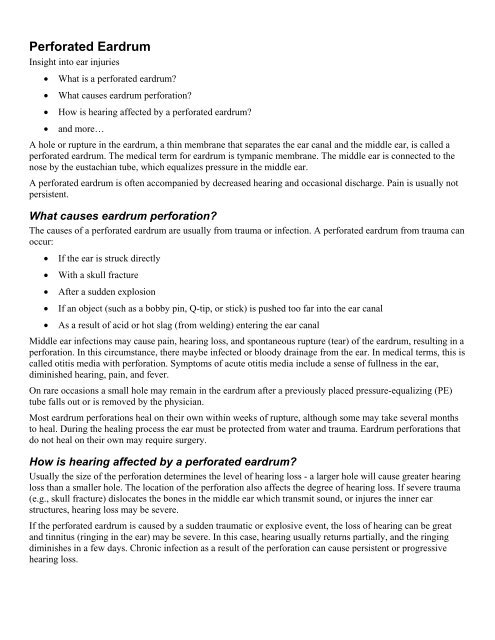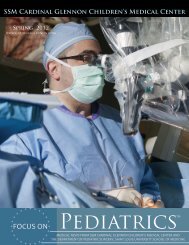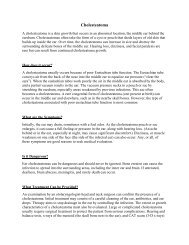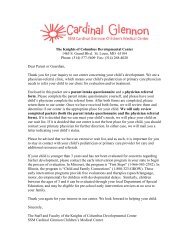Perforated Eardrum
Perforated Eardrum
Perforated Eardrum
You also want an ePaper? Increase the reach of your titles
YUMPU automatically turns print PDFs into web optimized ePapers that Google loves.
<strong>Perforated</strong> <strong>Eardrum</strong>Insight into ear injuries• What is a perforated eardrum?• What causes eardrum perforation?• How is hearing affected by a perforated eardrum?• and more…A hole or rupture in the eardrum, a thin membrane that separates the ear canal and the middle ear, is called aperforated eardrum. The medical term for eardrum is tympanic membrane. The middle ear is connected to thenose by the eustachian tube, which equalizes pressure in the middle ear.A perforated eardrum is often accompanied by decreased hearing and occasional discharge. Pain is usually notpersistent.What causes eardrum perforation?The causes of a perforated eardrum are usually from trauma or infection. A perforated eardrum from trauma canoccur:• If the ear is struck directly• With a skull fracture• After a sudden explosion• If an object (such as a bobby pin, Q-tip, or stick) is pushed too far into the ear canal• As a result of acid or hot slag (from welding) entering the ear canalMiddle ear infections may cause pain, hearing loss, and spontaneous rupture (tear) of the eardrum, resulting in aperforation. In this circumstance, there maybe infected or bloody drainage from the ear. In medical terms, this iscalled otitis media with perforation. Symptoms of acute otitis media include a sense of fullness in the ear,diminished hearing, pain, and fever.On rare occasions a small hole may remain in the eardrum after a previously placed pressure-equalizing (PE)tube falls out or is removed by the physician.Most eardrum perforations heal on their own within weeks of rupture, although some may take several monthsto heal. During the healing process the ear must be protected from water and trauma. <strong>Eardrum</strong> perforations thatdo not heal on their own may require surgery.How is hearing affected by a perforated eardrum?Usually the size of the perforation determines the level of hearing loss - a larger hole will cause greater hearingloss than a smaller hole. The location of the perforation also affects the degree of hearing loss. If severe trauma(e.g., skull fracture) dislocates the bones in the middle ear which transmit sound, or injures the inner earstructures, hearing loss may be severe.If the perforated eardrum is caused by a sudden traumatic or explosive event, the loss of hearing can be greatand tinnitus (ringing in the ear) may be severe. In this case, hearing usually returns partially, and the ringingdiminishes in a few days. Chronic infection as a result of the perforation can cause persistent or progressivehearing loss.
How is a perforated eardrum treated?Before attempting any correction of the perforation, a hearing test should be performed. The benefits of closinga perforation include prevention of water entering the ear while showering, bathing, or swimming (which couldcause ear infection), improved hearing, and diminished tinnitus. It also may prevent the development ofcholesteatoma (skin cyst in the middle ear), which can cause chronic infection and destruction of ear structures.If the perforation is very small, an otolaryngologist may choose to observe the perforation over time to see if itwill close spontaneously. He or she might try to patch a patient’s eardrum in the office. Working with amicroscope, your doctor may touch the edges of the eardrum with a chemical to stimulate growth and then placea thin paper patch on the eardrum. Usually with closure of the tympanic membrane, hearing is improved.Several applications of a patch (up to three or four) may be required before the perforation closes completely. Ifyour physician feels that a paper patch will not provide prompt or adequate closure of the hole in the eardrum,or if paper patching does not help, surgery may be required.There are a variety of surgical techniques, but most involve grafting skin tissue across the perforation to allowhealing. The name of this procedure is called tympanoplasty. Surgery is typically quite successful in repairingthe perforation, restoring or improving hearing, and is often done on an outpatient basis.Your doctor will advise you regarding the proper management of a perforated eardrum.
















